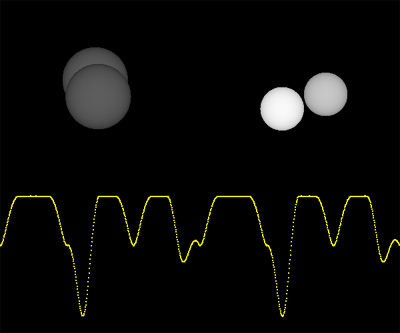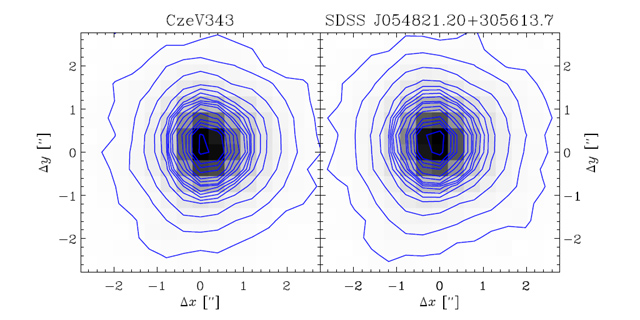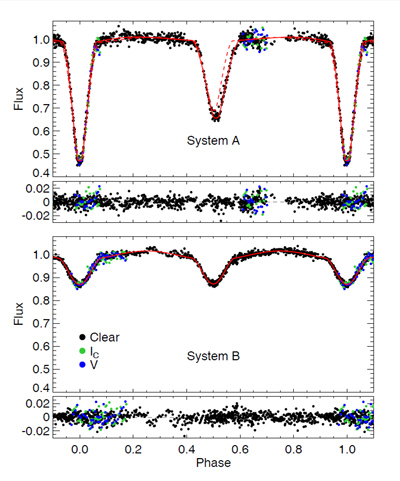|
CzeV343 is double eclipsing binary star, probably forming
hierarchical quadruple star system. Why we emphasize that both binary
systems are eclipsing? Observing of light drops, appearing when the
stars eclipse each other, can reveal number of properties about them,
especially when combined with other techniques like radial velocity
spectroscopy etc. Measuring of orbital time from the observed light
curve is obvious and easy, but the actual shape of light curve during
eclipses hints other properties like relative sizes, orbital plane
inclination etc. Differences in the amount of light drop in different
colors indicates mutual relation of star temperatures. Simply put,
when a binary star does not exhibit eclipses to observer on Earth, it
is difficult or close to impossible even to determine it is a binary
star. When both stars pass in front of and behind each other,
determining of number of properties of both stars can be done by
(relatively) cheap equipment on your backyard. And both binary
components of CzeV343 show prominent eclipses, which are easy to
observe, because of significant light drop (between
0.25 and 0.1 mag, compared to ~15 mmag drop of KIC 4247791 system B) and
very short periods (approx. 1.2 and
0.8 days).
CzeV343 is unique in one more way—orbital
periods of both binary stars are very close to 3:2 ratio. The relative
difference in orbital periods is only around
8.5 × 10-4,
which makes CzeV343 a quadruple star with both components orbital
periods closest to resonance from all other similar systems.
V994 Her component periods 2.08 and
1.42 days are also close to 3:2 ratio, but with
relative difference ~10-2 and orbital periods of the
KIC 4247791 binaries 4.10 and
4.05 days are close to 1:1 resonance, but again with
similar relative difference ~10-2.
Introducing KCTF
Majority of stars in the Galaxy (and I bet in other
galaxies, too :-) are not single ones (possibly with a family of
planets, e.g. like our Sun), but are gravitationally bound to
multiple star systems. While binary stars are simple in principle
(both stars orbit their barycenter), systems with three or more
stars are stable over long periods of time only if they are
hierarchically organized. For instance triple star with similar
distances (and thus similar orbital times) among all three stars
is inherently unstable, only stable configuration is a double star
orbited by a third star pretty far from the binary.
In 1962 Yoshihide Kozai showed in his study that a third star,
orbiting a close binary with orbital plane in certain inclinations
relative to orbiting plane of central binary, causes periodic
increasing of central binary star orbit eccentricity. Such effect
is called “Kozai cycles” now. Increasing eccentricity of
binary star orbit cause rapid increase of tidal friction within
stars when they pass through periastron. Tidal friction in binary
stars orbiting relatively far away (say on close to circular orbit
with orbital period tens of days and more) are negligible, they
almost do not influence the orbit. But when orbital eccentricity
is increased by Kozai cycle, both stars approach closer to each
other and tidal friction starts to dissipate significant portion
of their orbital (kinetic) energy. Of course tidal friction occurs
only when star's orbital period and period of rotation are not
equal. When both periods become locked, tidal friction disappears,
orbital energy is no longer dissipated by this mechanism and both
stars can stay on close orbit for a long time.
Kozai cycles together with increased tidal friction (often
referred as KCTF mechanism) is currently considered to be the
mechanism explaining existence of very close binaries with orbital
periods only days or fractions of a day (every variable star
observer already met numerous binary stars with periods shorter
than one day, even stars with periods shorter than 10 hours
are not that exceptional). Binary stars with such short period
could not form that close to each other, because mutual distance
of such stars is lower than the sum of radii of respective stars
in their early development stages. It is clear such close binary
stars had to be born much further away and KCTF is responsible for
their current proximity. Of course, a third star is necessary and
numerous studies prove a third companion is much more often
present around binary star with short period compared to stars
with longer orbital periods.
So KCTF is very important mechanism in stellar evolution and
numerous studies are focused to its research. Here comes the
importance of CzeV343—it is very likely
the orbital periods of both components were influenced by mutual
KCTF, but no theoretical studies about KCTF in quadruple stars
were published yet. And stars like CzeV343, showing eclipses of
both components, allowing to study their properties, with orbital
periods almost locked, provide material for extending our
knowledge about multiple star systems evolution.
CzeV343 discovery and observations
CzeV343 was discovered while monitoring of a patch of sky in
constellation Auriga around variable star MR Aur, performed
between January and April 2012. CzeV343 was among 44 variable
stars (and variable star suspects) detected in the field of view,
among which only three variable stars were previously known
(MR Aur, FV Aur and RZ Aur).
The field was imaged with G4-16000 CCD camera on commercial
25 cm Newtonian telescope with TeleVue Paracorr coma
corrector. Because the used optics cannot cover the full
4k × 4k pixels (16 MPx) of
the G4 camera, resolution was cropped to only 3k × 3k pixels (9 MPx) by camera driver.
Still, even after cropping the setup offers 71 × 71 arc-minutes field of view, despite
some vignetting and star image distortions in image corners.
Single 180 s exposure
of the target field of view in Auriga, resampled to 1/2 linear
dimensions (1/4 area), CzeV343 is marked with red dot
(left), G4-16000 camera on the 25 cm Newtonian telescope
(right) The variability of CzeV343 was first detected during the
observing run on January 30th, 2012. The star exhibited
Algol-type (detached eclipsing binary) variability, showing
clearly distinguished minima during occultations. However,
measured times of observed minima did not fit into
primary/secondary minimum period, typical for Algol-type stars.
After first four observing nights, the observed system B
minima were considered to be system A secondary minima. But
it was not possible to phase these minima with the system A
primary minimum. The problem was resolved after acquisition of
overlapped system A and system B minima on February
12th, which indicated the assumption the CzeV343 is
simple Algol-type binary star is probably wrong. Proper
system A secondary minimum was observed on March
3rd, 2012 for the first time.
Light curve of CzeV343 phased with ~1.2 days period of
system A (left) and with ~0.8 days period of system B
(right) CzeV343 shows two occultation periods, the system A period
was determined to 1.209373 days. The primary minimum is
0.24 mag deep and the secondary one is
0.13 mag deep. The system B period is
0.806931 days, with both primary and secondary minima only
around 0.11 mag deep. Both periods are
apparently very close to 3:2 ratio, but subsequent observations
showed a small difference. This difference can be clearly visible
on the light cure phased with system A period as a time drift
of system B minima.

Animation showing CzeV343 light curve as a sum of light
curves of two eclipsing binaries (click the image to run
animation) Attempts to resolve CzeV343 components
As already noted, it is currently not proven that CzeV343 is a
real quadruple star. Both binary stars could be physically
unrelated and we can only see them on the same position. But
number of circumstantial evidences hint CzeV343 is a quadruple
system—stars have similar masses, similar
temperatures as demonstrated by the acquired photometry in
different colors, similar periods very close to 3:2 resonance, ...
Still number of attempts to distinguish both stars by various
techniques were performed.
Star image centroid shift examination
The centroid of star image (mean of position of individual
pixels comprising star image weighted by particular pixel
flux—centroid allows to determine star
position with precision significantly surpassing angular size
of single pixel) was examined during occultations. We measured
CzeV343 image centroid coordinates relative to the close
neighboring star in the field of view, determined by the SIPS
software astrometry tool. However, relatively low resolution
images with 1.39''/pixel sampling, acquired
with the photometry telescope, had to be used, because we need
to try to detect centroid movement during star occultations.
The assumption is weakening of one star contribution to the
integrated flux during its occultation would shift image
centroid towards the second star. Only images from individual
observing runs (single nights), on which both observed star
and selected comparison star were placed in the same position
relative to the camera field of view, were mutually compared
to eliminate influence of telescope (and especially
coma-corrector) image distortions.
Images below show our results from January 31st,
2012, when the system A passed through a primary minimum.
The top pane on the left image shows CzeV343 light curve
during system A occultation, lower two panes show
centroid shift during occultation independently in CCD x and y
axes in arc-seconds. Right image shows so-called
“rainfall” chart, where centroid shift is displayed on
x-axis and star magnitude on y-axis (independent shifts in x
and y CCD directions are displayed on two panes). Any shift of
image centroid would result into “beveled
rainfall”.
CzeV343 centroid did now show any detectable shifts
during occultation, as showed on time-dependent chart (left)
and “rainfall” chart (right) Same analysis was performed for two more nights—system B minimum (system B primary and
secondary minima have almost exactly the same depth) on
February 10th, 2012 and partially overlapped
system B minimum and system A secondary minimum on
February 26th, 2012. None of them showed any
significant movement of CzeV343 centroid during occultation.
Because the calculated error margins of the determined
centroid was unrealistically low, we assume centroid shift
method did not reveal any changes up to 0.5
arc-second.
Star image shape examination
Our telescope/camera used 1.39"/pixel
sampling with typical star FWHM around 4". CzeV343 showed no
shape distortions on individual frames, but the resolution of
photometric telescope is too low. Fortunately CzceV343 can be
found in Sloan Digital Sky Survey (SDSS) Data Release 7 (DR7)
archive. SDSS sampling is only 0.396"/pixel
and typical seeing is below 1". Even on SDSS images with
significantly better resolution CzeV343 shows no visible image
distortions hinting the star image consists of two blended
stars.
CzeV343 image from the 0.25 m
photometric telescope (left) and z filter image from
2.5 m SDSS telescope (right) Still the CzeV343 SDSS image was carefully examined. The
star shape was enlarged and interpolated to show isophotes and
then compared with the similarly processed image of a nearby
star from the same SDSS frame. Both shapes are very
similar.

Comparison of CzeV343 shape and nearby star shape
on SDSS image The result is CzeV343 cannot be resolved using currently
available data. Other observations like hi-res imaging using large
telescope with adaptive optics would be beneficial.
CzeV343 analysis and modeling
Analysis of light curve containing overlapped occultations is
quite difficult. Computer modeling of the observed multiple star
helps to find best fit for system parameters (orbital periods,
orbital plane inclinations, eccentricity, star diameter relations
etc.) and to verify the hypothesis about multiple star structure.
The best fit than can be used to separate contributions of each
binary star to the observed light curve. So the good model of the
system allows creating of phased light curves of both binary
components as well as to express residuals, revealing data
reliability and photometry precision.
We used the cmpfit routine to fit multiple model parameters
simultaneously by minimizing χ2
of the model generated with JKTEBOP program written by John Southworth.
Resulting χ2 of our model is
1040—very close to the theoretical
minimum, which equals to the model's number of degrees of
freedom (800 in our case). Such result not only shows the
credibility of the model itself, but also demonstrates the quality
of the acquired photometry data, obviously not affected by
important systematic errors, instrumental errors etc.

Separated light curves of CzeV343
system A (top pane) and system B (bottom pane)
together with residuals The red lines on the above image show the best-fit light curves
of both CzeV343 components. Resulting orbital eccentricity of the
system A is 0.18, as shown by the solid red
line. Model with system A eccentricity set to 0 (dashed red
line) showed significantly worse fit. System B orbit
eccentricity was set to 0, the observed light curve does not
exhibit any significant phase shift of system B secondary
minima.
| Parameter |
System A |
System B |
| P [d] |
1.209373 |
0.806931 |
| T0 [JD] |
2455958.36058 |
2455968.33977 |
| i [°] |
90.0 |
67.11 |
| e cos ω |
0.0147 |
= 0 |
| e sin ω |
0.178 |
= 0 |
| σ |
0.590 |
0.989 |
| r1 + r2 |
0.4533 |
0.581 |
| r1/r2 |
1.267 |
1.05 |
Czev343 parameters The presented model very well describes CzeV343 as two
eclipsing binaries. The code is made freely available not only to
allow analysis of further CzeV343 observations, but also for
possible use of the code for modeling of other similar multiple
star systems.
Article about CzeV343 discovery and analysis was accepted for
publication in the Astronomy & Astrophysics Vol. 544 (August
2012).
CzeV343 identification:
Links:
All images on this page courtesy O. Pejcha, V. Pribik and P.
Cagas.
| 